Camp Humphreys
- Not to be confused with Camp A. A. Humphreys in Virginia, now known as Fort Belvoir.
| United States Army Garrison Humphreys | |
|---|---|
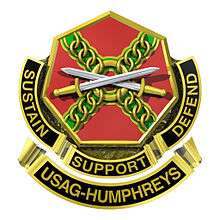 We are the Army's Home | |
| Active | 1950–present |
| Country |
|
| Branch |
|
| Type | Garrison |
| Part of | |
| Motto(s) | Sustain, Support, Defend |
| Colors |
Red, green, black & gold |
| Website | Official Website |
| Commanders | |
| Garrison Commander | Colonel Scott Mueller, U.S. Army |
| Deputy to the Garrison Commander | Mr. Robert Brown |
| Garrison Command Sergeant Major | Command Sergeant Major Antonio Lopez, U.S. Army |
Coordinates: 36°58′N 127°02′E / 36.967°N 127.033°E
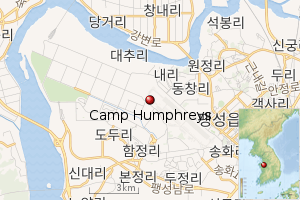 |
Camp Humphreys (Korean: 캠프 험프리스), also known as United States Army Garrison-Humphreys (USAG-H), is a United States Army garrison located near Anjeong-ri and Pyeongtaek metropolitan areas in South Korea.[1] Camp Humphreys is home to Desiderio Army Airfield, the busiest U.S. Army airfield in Asia, with a 8,124-foot runway.[2] In addition to the airfield, there are several U.S. Army direct support, transportation, and tactical units located there, including the Combat Aviation Brigade, 2nd Infantry Division. The garrison has an area of 3,454 acres and cost US$11 billion.[3] Camp Humphreys is the largest U.S. overseas military base, housing some 500 buildings and amenities.[4]
In 2004, an agreement was reached between the United States and South Korean governments to move all U.S. forces to garrisons south of the Han River and relocate the United States Forces Korea and United Nations Command Headquarters to Camp Humphreys.[5] Those movements were expected to be completed by 2016 to transform Camp Humphreys into the largest U.S. Army garrison in Asia, but as of 2018 this has not yet happened.[6] Under that plan, the 28,500 U.S. troop presence in South Korea will be consolidated by 2016 and United States Forces Korea will move from Yongsan Garrison in Seoul to Camp Humphreys.[7][8] Camp Humphreys is 40 miles south of the former base in Seoul and about 60 miles from the Demilitarized Zone that divides North and South Korea. That puts the base about twice as far from North Korea as its predecessor, one of the main reasons for the move.[9]
Geography
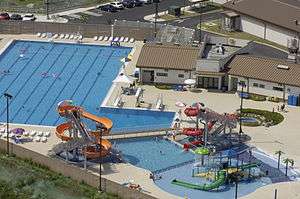

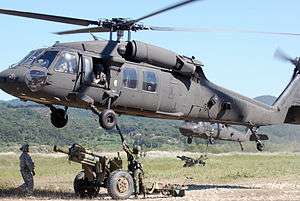
The town of Anjeong-ri is located adjacent to the Camp Humphreys main gate. Smaller farming villages are located along the perimeter.[10]
The installation covers an area of 1,210 acres. As part of the Yongsan Relocation Plan, that number will grow by 2,328 acres to 3,538 acres.
The immediate area around Camp Humphreys is mostly agricultural and consists mainly of rice fields. There are some rolling hills in the vicinity, but for the most part the elevations are less than 150 feet. There is a small mountain range about seven miles south of Camp Humphreys, with peaks reaching 958 feet in elevation. Larger mountains are located to the northeast, east, and southwest, all within 20 miles with peaks reaching to 2,293 feet in elevation to the south and 1,000 feet in elevation to the southeast. Urban areas are situated mostly to the northeast of the airfield. Seoul is located approximately 55 miles northeast.
The Ansong River flows from the east to west toward the West Sea and passes three miles northwest of the airfield. About 12 miles west of Camp Humphreys, the river widens and empties into the Asan Bay, near Koon-ni Range.
The numerous areas of water around Camp Humphreys has an effect on the weather. The abundant moisture is responsible for most of the fog and stratus which occurs in the area. This is especially true from the spring through fall.
 Camp Humphreys Middle/High School Gymnasium.
Camp Humphreys Middle/High School Gymnasium. U.S. Army Garrison Humphreys.
U.S. Army Garrison Humphreys. 2011 Korea-America Friendship Festival in Anjung-ri.
2011 Korea-America Friendship Festival in Anjung-ri. Construction of three family housing towers on Camp Humphreys.
Construction of three family housing towers on Camp Humphreys. Map of Pyeongtaek showing location of Camp Humphreys.
Map of Pyeongtaek showing location of Camp Humphreys. 2011 construction on Camp Humphreys.
2011 construction on Camp Humphreys.- Splish and Splash Water Park.
 Fire Department Training.
Fire Department Training.
History
The history of Camp Humphreys dates back to the beginning of the 20th century when, in 1919 the Japanese military built the Pyeongtaek Airfield. Later, during the Korean War, Pyeongtaek Airfield was named K-6 after being repaired and enhanced by the U.S. Air Force to accommodate a U.S. Marine Air Group and the 614th Tactical Control Group.[11]
1960s
In 1962, the base was renamed Camp Humphreys in honor of Chief Warrant Officer Benjamin K. Humphreys, a pilot assigned to the 6th Transportation Company, who died in a helicopter accident.[12]
In 1964, Humphreys District command (later re-designated as the 23rd Direct Support Group) was activated as a separate installation command of the Eighth U.S. Army providing all direct support, supply and maintenance, storage of all conventional ammunition in Korea, Adjutant General publications and training aides and the Eighth U.S. Army Milk Plant.[13]
1970s
In 1974, with the activation of the 19th Support Brigade, Camp Humphreys was redesignated as U.S. Army Garrison, Camp Humphreys. USAG-Camp Humphreys was still responsible for all affairs affecting personnel stationed at Camp Humphreys, but the 19th Support Command was responsible for all support activities vital to the Eighth U.S. Army and its subordinate units. Those units formerly reporting to the 23rd Direct Support Group reported to the 19th Support Command in Daegu. Only the basic functions remained with USAG Camp Humphreys.[13]
1990s
Later, the 23rd Direct Support Group and 19th Support were renamed 23rd Support Group and 19th Theater Army Area Command. On 17 June 1996 the United States Army Support Activity Area III (USASA Area III) was established and made responsible for the peacetime support mission for Camp Humphreys, Camp Long, Camp Eagle and U.S. Army units assigned to Suwon Airbase.[13]
2000s
On 1 June 2005, the U.S. Army announced that Camps Eagle and Long would close. Both camps were then later closed on 4 June 2010, consolidating installation support activities on Camp Humphreys.[13]
2005 protests
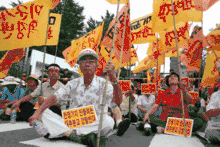
The Daechuri Protests were a series of large protests against the South Korean and American governments' plan to expand Camp Humphreys to make it the main base for most U.S. troops in South Korea. It concluded when residents of Daechuri and other small villages near Pyeongtaek agreed to a government settlement to leave their homes in 2006 and allow for the base expansion.[14][15] Compensation for the land averaged 600 million won (about 600,000 USD) per resident.[16]
Under a 2004 land-swap pact, the U.S. promised to gradually return a combined 170 square kilometers of land housing 42 military bases and related facilities to South Korea and move U.S. military forces from garrisons in and north of Seoul to Camp Humphreys.[7]
With the creation of the Installation Management Command on 24 October 2006, U.S. Army Support Activity Area III was redesignated as U.S. Army Garrison Humphreys and Area III on 15 March 2007.[13]
On 13 November 2007, USFK and South Korean officials conducted a groundbreaking ceremony for the expansion of Camp Humphreys.[6] Under that plan, the 28,500 U.S. troop presence in South Korea will be consolidated into two regional hubs in Pyeongtaek and Daegu by 2016.[8]
2010s
In 2010 the U.S. Army announced that a tour normalization policy would gradually be introduced, where single soldiers will typically serve two-year tours, and troops who bring families will stay for three years. Previously most troops served one-year unaccompanied tours in Korea. Additional infrastructure to accommodate more families would be built.[17]
On 2 September 2011, U.S. and South Korean officials participated in a joint groundbreaking ceremony to mark the beginning of construction for an elementary school to accommodate 850 students and high school to accommodate 950 students on Camp Humphreys.[18][19] On 26 August 2013, Camp Humphreys opened a new elementary school.[20] The new elementary school will hold kindergarten through fifth-grade classes for a total enrollment capacity of 875 students.[19][20]
As of 2017 the U.S. Army called Humphreys "the largest power projection platform in the Pacific".[21][22] When the final stage of base expansion is completed about 2020, Humphreys will have tripled in size to nearly 3,500 acres making it the largest U.S. overseas military base. To accommodate more families, up to twelve 12-story housing towers will be built. The population of Humphreys is expected to exceed 45,000. Up to 93% of the $10.7 billion expansion cost will be paid by South Korea under a 2014 Special Measures Agreement.[21][23]
- Wrecked North Korean tank on bridge near Pyeongtaek during the Korean War.
 Marines at K-6 Air Base pose for a photo during the Korean War.
Marines at K-6 Air Base pose for a photo during the Korean War.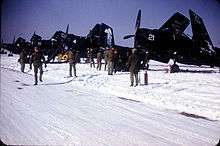 VMA-251 Thunderbolts at Pyongtaek airfield (K-6), South Korea, in 1953/54.
VMA-251 Thunderbolts at Pyongtaek airfield (K-6), South Korea, in 1953/54. A U.S. Marine Corps Douglas AD-2 Skyraider during the Korean War.
A U.S. Marine Corps Douglas AD-2 Skyraider during the Korean War. U.S. Army OV-1D Mohawk taken at Camp Humphreys.
U.S. Army OV-1D Mohawk taken at Camp Humphreys. U.S. Army OV-1D Mohawk's last flight at Camp Humphreys.
U.S. Army OV-1D Mohawk's last flight at Camp Humphreys. A C-130 Hercules aircraft lands at the Camp Humphreys airfield.
A C-130 Hercules aircraft lands at the Camp Humphreys airfield. UH-1N Iroquois (Huey) utility helicopter (right) takes off from the flight line at Camp Humphreys.
UH-1N Iroquois (Huey) utility helicopter (right) takes off from the flight line at Camp Humphreys. AH-64D Apache Longbow helicopters flying at Camp Humphreys in February 2004.
AH-64D Apache Longbow helicopters flying at Camp Humphreys in February 2004.- A CH-47 Chinook helicopter flies at Camp Humphreys.
 2011 mass casualty exercise at Camp Humphreys.
2011 mass casualty exercise at Camp Humphreys. Camp Humphreys Memorial Park.
Camp Humphreys Memorial Park.
Occupants
Camp Humphreys is home to the following units:
- United States Forces Korea
- United Nations Command
- Combined Forces Command
- United States Marine Corps Forces, Korea
- Eighth United States Army
- 2nd Infantry Division
- Installation Management Command Pacific – Forward
- 2nd Combat Aviation Brigade
- 65th Medical Brigade
- United States Army Medical Department Activities Korea
- 501st Military Intelligence Brigade
- 1st Signal Brigade
- 411th Contract Support Brigade
- Armored Brigade Combat Team – Rotational unit
- Far East District of the United States Army Corps of Engineers
- 7th Republic of Korea Air Force Communication Service Group
- Trial Defense Services
- Defense Logistics Agency
- American Forces Network Humphreys, Defense Media Activity
- Army Materiel Command Logistics Support Element
- 658th Regional Support Group
- United States Army Pacific Support Unit
- 4-58th Airfield Operations Battalion
- 11th Engineer Battalion
- 23rd Chemical Battalion
- 602nd Aviation Support Battalion
- 4th Attack Reconnaissance Battalion, 2nd Aviation Regiment
- 2nd Assault Battalion, 2nd Aviation Regiment
- 3rd General Support Aviation Battalion 2nd Aviation Regiment
- 194th Combat Sustainment Support Battalion
- 94th Military Police Battalion
- 3rd Military Intelligence Battalion
- 524th Military Intelligence Battalion
- 532nd Military Intelligence Battalion
- 719th Military Intelligence Battalion
- Heavy Attack Recon Squadron – Rotational unit
- 718th Explosive Ordnance Disposal Company
- 568th Medical Company
- 618th Dental Company
- 106th Veterinary Company
- 339th Quartermaster Company
- 501st Signal Company
- 19th Human Resource Company
- 520th Ordinance Company
- 142nd Military Police Company
- 557th Military Police Company
- 8th Korean Service Corps Company
- 22nd Korean Service Corps Company
- Charlie Company, 6th Battalion, 53rd Air Defense Artillery Regiment
- Headquarters and Headquarters Company, United States Army Garrison Humphreys
- Detachment 2, 607th Weather Squadron, United States Air Force
- Detachment Alpha, Bravo and Headquarters and Headquarters Company, 176th Finance Battalion
- 20th Public Affairs Detachment
- 5th Medical Detachment
- 95th Medical Detachment (Blood)
- 20th Military Police Detachment (CID)
- 503rd Military Working Dog Detachment
- 138 Movement Control Team
- 662nd Movement Control Team
- US Army Correctional Activity – Korea
Department of Defense Dependent Schools
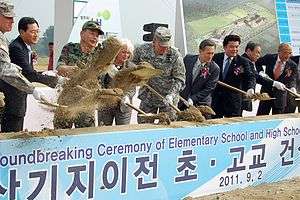
The Department of Defense Education Activity (DoDEA) is a civilian agency of the United States Department of Defense that manages all schools for military children and teenagers, as well as foreign service children and teenagers, in the United States and also overseas at American military bases worldwide.[24]
DoDEA currently manages four schools on Camp Humphreys. They include Humphreys Central and West Elementary Schools, Humphreys Middle School and Humphreys High School.[25]
In 2011, construction began on a new Camp Humphreys for a central elementary and high school. In 2013, construction completed the new schools and adjacent athletic fields accommodate 1,700 students. Humphreys Central Elementary School can accommodate 850 students with the high school accommodating 950. The elementary school serves kindergarten through fifth-grade classes, the middle school serves 6th and 7th grades and the high school cover 8th through 12th grades.
Post exchange (AAFES)
Camp Humphreys is home to a 72,000 square foot concession mall, with laundry and dry Cleaning services, an optical shop, LG Uplus(Mobile, Internet, CATV ETC), barber shop, florist, embroidery, giftware vendors and more. The AAFES food court offers Popeye's Chicken, Taco Bell, Anthony's Pizza, Subway and Baskin Robbins Ice Cream. Anthony's Pizza and Popeye's also offer daily delivery service.[26]
There are also three Shoppettes on Camp Humphreys. The Zoeckler Station shoppette is located near the main gate by the KATUSA snack bar and Pizza Hut. Pizza Hut offers delivery service daily for on-post residents. Also located near this facility, across from the walk-thru gate, is laundry/dry cleaning service and a AAFES barber shop. The 3rd MI shoppette is located in the same building as Charley's Steakery, which serves a selection of sub sandwiches.[26]
The post movie theater seats more than 550 customers and offers the latest movies in digital sound. The theater was recognized in 2011 as the "Best in the Army."
A 24-hour laundromat is located adjacent to the walk-thru gate to Camp Humphreys.[26]
Korea is a ration control assignment. Upon arrival, military personnel, family members and civilian employee need to get a ration control card from their local Pass and ID Office prior to shopping in an AAFES facility. Department of Defense identification cards and ration control cards are always necessary to enter all AAFES facilities in South Korea.[26]
Army Health Clinic
The Camp Humphreys Army Health Clinic provides outpatient primary care services to active duty service members and their families living in the Pyongtaek area. Patients must be enrolled in the clinic via TRICARE and assigned a primary care provider prior to scheduling appointments.[27]
In popular culture
- Camp Humphreys is featured in the 2013 film World War Z.[28]
See also
References
- ↑ U.S. Army Garrison Humphreys Official Website Archived 3 September 2011 at the Wayback Machine.
- ↑ "Humphreys' airfield gets facelift".
- ↑ "As North Korea intensifies its missile program, the U.S. opens an $11 billion base in the South". The Washington Post. Retrieved 29 July 2017.
- ↑ Herald, The Korea (7 November 2017). "Moon welcomes Trump at US base".
- ↑ "Background Note: South Korea". U.S. Department of State. Retrieved 7 July 2011.
- 1 2 "Camp Humphreys Groundbreaking Ceremony Speech". United States Forces Korea. Archived from the original on 12 December 2012. Retrieved 13 November 2007.
- 1 2 "Yongsan Garrison to Be Relocated by 2014". Korea Times. Retrieved 11 July 2006.
- 1 2 "Yongsan relocation plan moving forward". Stars and Stripes Newspaper. Retrieved 2 September 2011.
- ↑ "New U.S. base not entirely out of range of North Korea threats".
- ↑ Pike, John. "Camp Humphreys". www.globalsecurity.org.
- ↑ history U.S. Army Garrison Humphreys Official History Archived 30 June 2010 at the Wayback Machine.
- ↑ "Ground broken for 2 new schools for military families in Korea".
- 1 2 3 4 5 U.S. Army Garrison Humphreys Official History Archived 17 February 2013 at the Wayback Machine.
- ↑ "Ceremonies honor residents driven from lands slated for Humphreys expansion". Stars and Stripes. Retrieved 9 April 2007.
- ↑ "S. Koreans rally at Camp Humphreys fence to protest U.S. presence". Stars and Stripes. Retrieved 10 August 2005.
- ↑ "Daechuri issue sees no resolve". The Hankyoreh. Retrieved 2 January 2012.
- ↑ Miles, Donna (27 July 2010). "Korea tour normalization". U.S. Army. Retrieved 12 May 2018.
- ↑ "Ground broken for two DODEA schools key to S. Korea relocation plan". Stars and Stripes Newspaper. Retrieved 2 September 2011.
- 1 2 "Ground broken for 2 new schools for military families in Korea". Retrieved 6 September 2011.
- 1 2 "Camp Humphreys opens new elementary school". Retrieved 29 August 2013.
- 1 2 Letman, Jon (6 November 2017). "USAG Humphreys: The Story Behind America's Biggest Overseas Base". The Diplomat. Retrieved 12 May 2018.
- ↑ 2016 Annual Report: U.S. Army Garrison Humphreys (Report). U.S. Army. 3 May 2017. Retrieved 12 May 2018.
- ↑ "Special Measures Agreement". United States Forces Korea. 2 February 2014. Retrieved 12 May 2018.
- ↑ "link to List of DoEA school districts worldwide". Archived from the original on 14 December 2010.
- ↑ Communications, DoDEA. "Pacific School Websites". www.dodea.edu.
- 1 2 3 4 "S. Exchange (AAFES)". USAG-Humphreys. Archived from the original on 3 January 2012. Retrieved 12 January 2012.
- ↑ "Army Health Clinic". U.S. Army Garrison Humphreys. Archived from the original on 16 January 2012. Retrieved 12 January 2012.
- ↑ "No Place Doing Well". World War Z. YouTube. 2013. Retrieved 17 June 2013.
External links
| Wikimedia Commons has media related to Camp Humphreys. |